Teochew-style steamed fish is a traditional Chinese dish known for its fresh flavor and simplicity. This dish features unique special ingredients, including salted plums, preserved salted vegetables, tomatoes, and ginger. Together, these ingredients create a distinct blend of sour, savory, and slightly spicy flavors found only in Teochew-style steamed fish.
Originating from Teochew (Chaozhou/潮州) in the eastern part of Guangdong province, China, this dish has gained immense popularity in Southeast Asia, particularly among Teochew communities in Singapore and Malaysia. This recipe will present the traditional Malaysian way of preparing Teochew steamed fish.
Note: This post may contain affiliate links. Please read my privacy policy for more info. I may receive commissions for purchases made through links in this post. As an Amazon Associate, I earn from qualifying purchases.
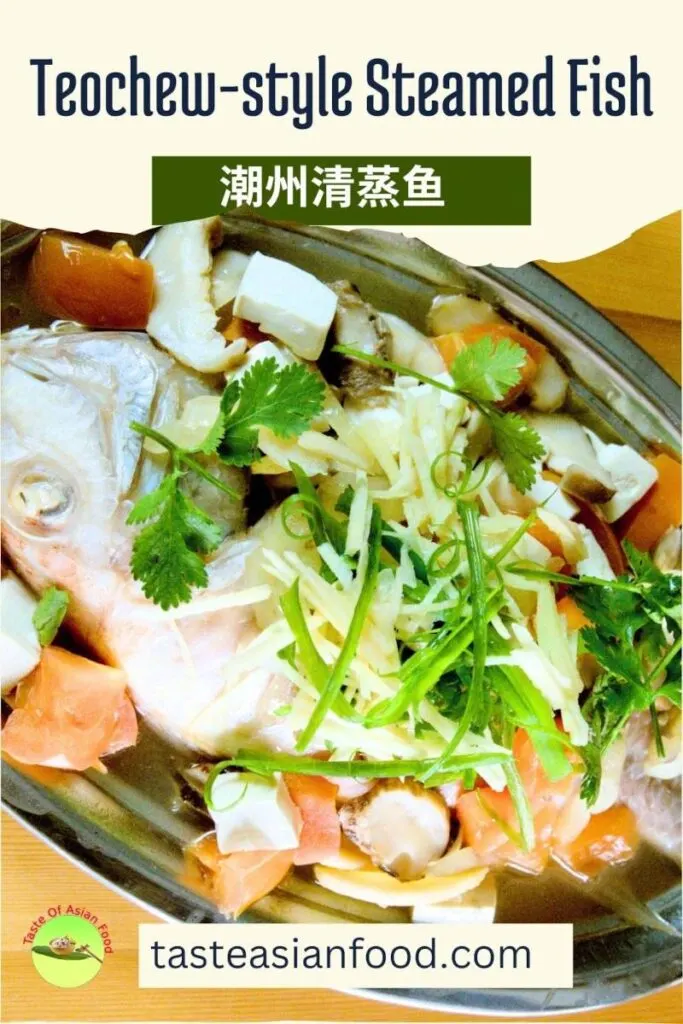
1. Primary Ingredients Required for Teochew Steamed Fish
- Fish. You can use various types of fresh fish, including white pomfret or other white-fleshed fish such as seabass, tilapia, grouper, snapper, and cod. I purchased the whole fish from the wet market, but you can also use fish fillets.
- Ginger. Ginger is an essential ingredient that helps remove the unwanted smell of fish. It is commonly used in most Chinese fish recipes. In this recipe, we will use ginger slices as well as finely chopped ginger.
- Salted vegetable. Another essential ingredient is pickled vegetables. Various types of pickled vegetables are used in Chinese cuisine. For this recipe, I use 咸菜 (xián cài), the most common choice for the Malaysian version. Other names for pickled vegetables include 榨菜 (zhà cài), 酸菜 (suān cài), 雪菜 (xuě cài), 梅菜 (méi cài), and 冬菜 (dōng cài). These can also be included in the steamed fish recipe.
- Salted plum. The most unique ingredient in this dish is the salted plum (also called sour plum). It is a specialized ingredient, so it might be hard to find outside Asia. However, if you live in a place with a large Chinese community, you may try to get it from your favorite Asian grocery stores.
- Others. Other secondary ingredients are tomatoes, tofu, and Chinese dried mushrooms. I will include all these ingredients in this recipe, but you can omit them without significantly affecting the overall taste. You may also add some chili if you prefer a spicier dish.
- Seasoning. Lastly, the seasonings are simple: fish sauce, wine, salt, and sugar. I have added sugar because the preserved vegetables and salted plums are sour, and sugar helps to balance that flavor. Fish sauce is my twist on the original recipe, but you can use light soy sauce instead. You may also add some sesame oil if you like its taste.

2. How to Prepare Teochew-Style Steamed Fish
1. Ask your fish vendor to descale and clean up the cavity of the fish for you, which saves you from doing the messy work at home. Next, prepare all the ingredients required for the sauce. This includes soaking and cutting the mushrooms, slicing the salted vegetable into strips, cutting the tomato into wedges, and slicing the ginger into fine strips. Also, remove the seeds of the plums and cut the tofu into cubes.
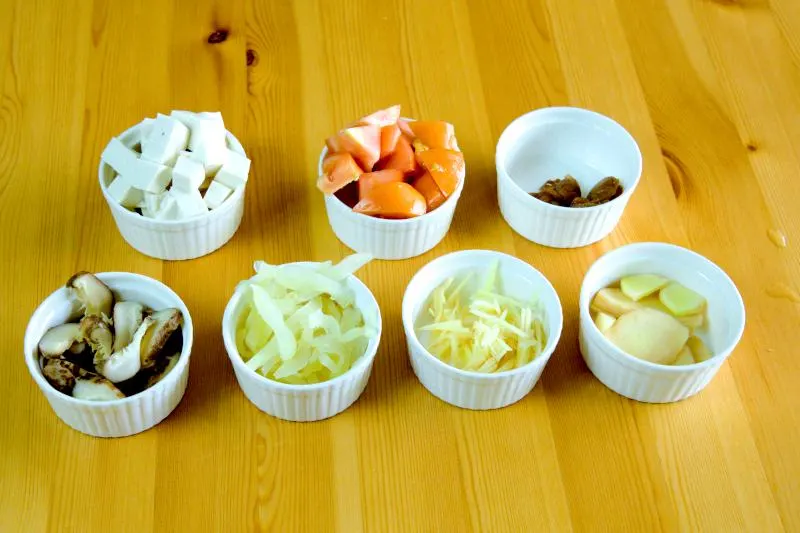
2. Sauté the slices of ginger lightly in oil. Next, add the tomato wedges, salted vegetables, mushrooms, salted plums, and 1.5 cups of water. Bring the mixture to a boil, then season it with fish sauce, salt, sugar, and wine. Add the tofu later, as it doesn’t need to cook for long and can break easily if added too early. Taste the sauce and adjust the flavor as needed. This sauce will be poured over the fish before serving.
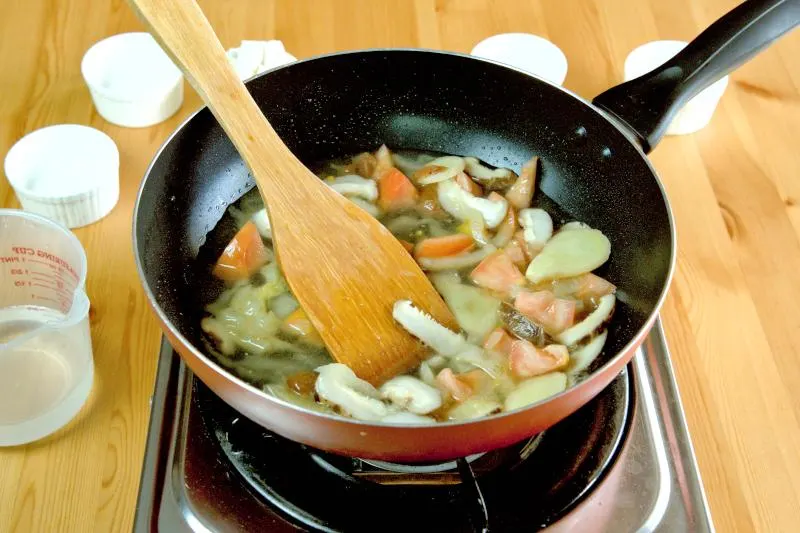
3 To steam the fish, place two chopsticks on a stainless steel plate. Place the fish on top of the chopsticks to create a space between the fish and the plate. This allows steam to reach the bottom of the fish, helping cook both sides of the fish evenly.
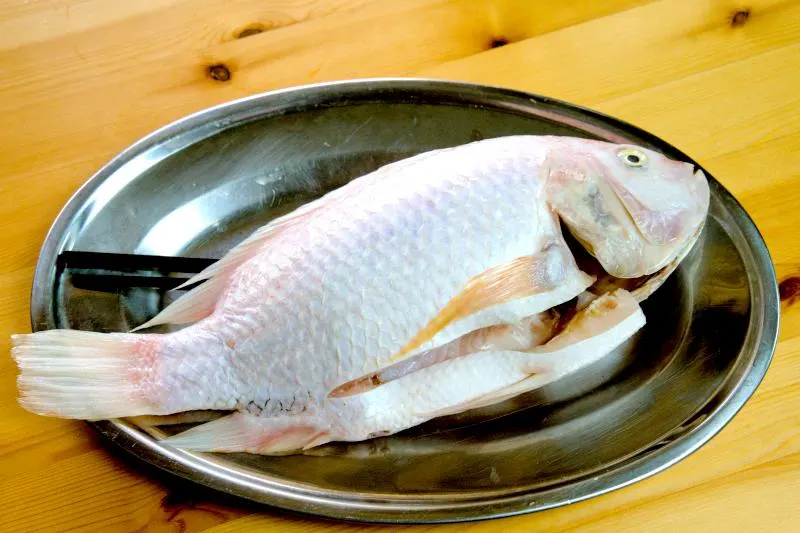
4. Steam the fish over high heat with rolling boiling water for approximately 8 minutes for a fish weighing about 500 grams. Check the doneness of the fish after 8 minutes. A properly cooked fish will have protruding eyes and flaky flesh.
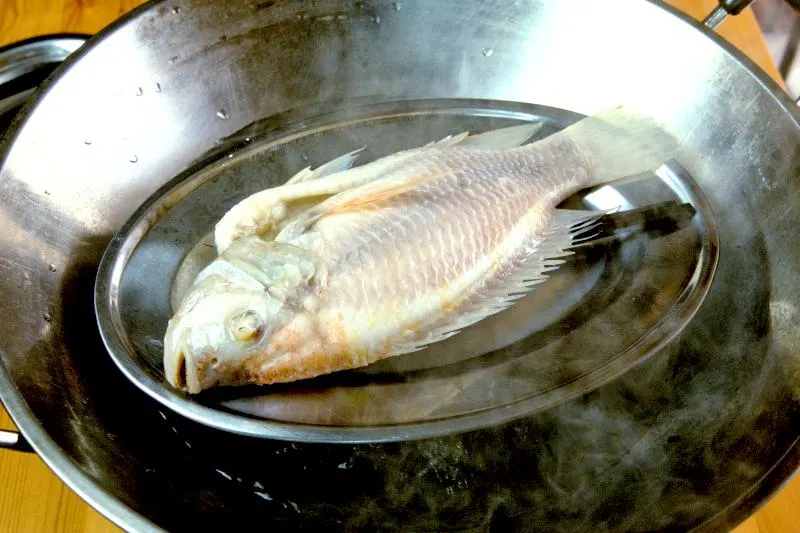
5. Discard any liquid that collects in the plate after steaming, as it can be fishy. Place the fish on a serving plate and pour the sauce (and ingredients) over it. Finally, add green onions and ginger strips on top. Pour hot oil over the green onions and ginger to partially cook them, which enhances the aroma. The fish is now ready to be served!
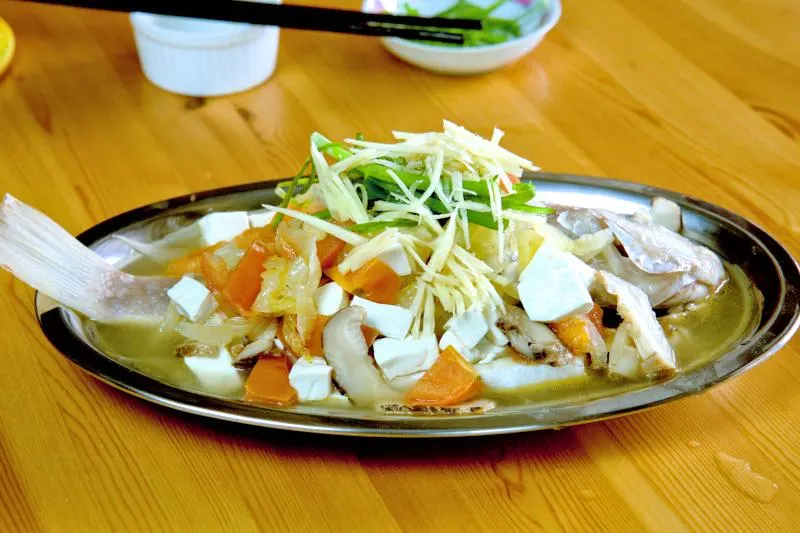
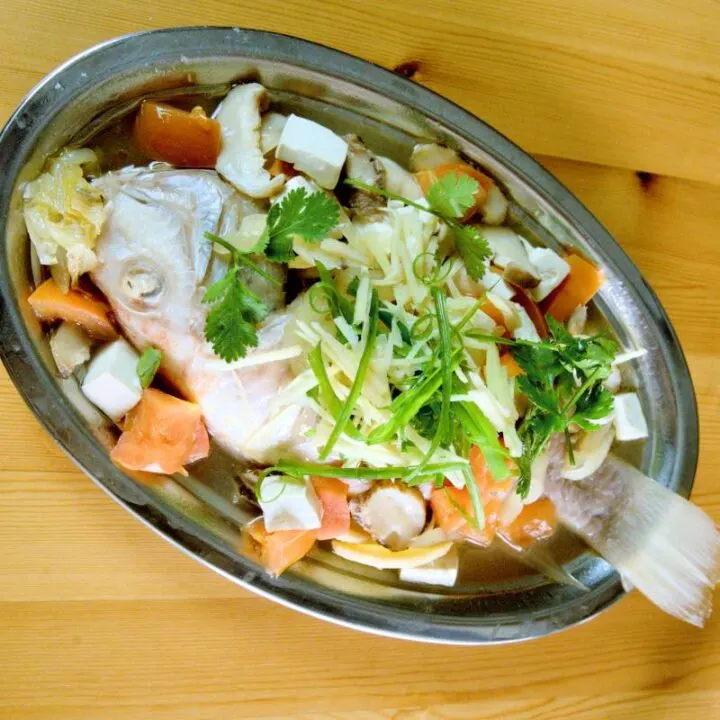
Teochew-style Steamed Fish
Prepare the Teochew-style steamed fish, a classic Chinese dish that is especially popular in Malaysia and Singapore.
Ingredients
Ingredients A
- 1 tilapia
- 30g ginger, cut into slices and the other half into fine strips
- 3 dried shiitake mushrooms
- 80g salted preserved vegetable, cut into strips
- 3 salted plums
- 1 medium-sized tomatoes,
- 200g tofu
- 1 bird’s eye chili (optional)
- 1.5 cups water
- spring onion and coriander leaves to garnish
Ingredients B (Seasoning)
- 1/2 tsp salt
- 1/2 tsp sugar
- 1 tbsp fish sauce
- 1 tbsp Chinese rice wine
- 2 tbsp of hot oil
Instructions
- Ask your fish vendor to descale and gut the fish.
- Next, prepare all the ingredients required for the sauce. This includes soaking and cutting the mushrooms, slicing the salted vegetable into strips, cutting the tomato into wedges, and slicing the ginger into fine strips. Also, remove the seeds of the plums and cut the tofu into cubes.
- Sauté the ginger lightly with oil. Then, add all the above ingredients, along with 1.5 cups of water, and bring the mixture to a boil.
- Add the seasoning: fish sauce, salt, sugar, and wine.
- Place two chopsticks on a stainless steel plate to steam the fish. Put the fish on top of the chopsticks. Steam the fish over high heat with rolling boiling water for approximately 8 minutes. A properly cooked fish will have protruding eyes and flaky flesh.
- After steaming, discard any liquid that collects on the plate. Place the fish on a serving plate and pour the sauce (and ingredients) over it.
- Finally, add green onions and ginger strips on top. Pour hot oil over the green onions and ginger to partially cook them.
Recommended Products
As an Amazon Associate and member of other affiliate programs, I earn from qualifying purchases.
Nutrition Information:
Yield: 2 Serving Size: 1Amount Per Serving: Calories: 702Total Fat: 39gSaturated Fat: 8gTrans Fat: 0gUnsaturated Fat: 25gCholesterol: 99mgSodium: 2357mgCarbohydrates: 37gFiber: 7gSugar: 12gProtein: 54g
This data was provided and calculated by Nutritionix on 11/21/2024
3. Tips to get the best result for the steamed fish
- Splashing hot oil over the fish will partially cook the green onions and ginger, enhancing their aroma.
- I recommend using fresh fish whenever possible for any steamed fish recipe, as it highlights the fish’s flavor. For the tofu, please use semi-firm tofu, as silken tofu is too soft and can break easily during cooking.
- Season the sauce with a more intense flavor, as it will be served with the unsalted fish.
4. How long should I steam the fish?
The optimal steaming time for the fish depends on its size and thickness. Here are general guidelines to ensure the fish is steamed perfectly:
- Small, thin fillets: Steam for 4-5 minutes. This is ideal for fillets less than half an inch thick.
- Medium-sized fish (600-800g): Steam for about 8 minutes.
- For larger fish (800g-1kg), Increase the steaming time to approximately 10 minutes. Add another 2 minutes for fish larger than that.
5. About Salted Plums
One of the most unique ingredients in this dish is salted plums, known as 咸水梅, which are sold in a salted brine. The result is a complex flavor that combines sweet, sour, and salty notes. This flavor can be somewhat of an acquired taste, featuring hints of licorice and dry tangerine peel. The preservation process enhances the flavors of the plums, introducing a savory element that makes them truly unique.
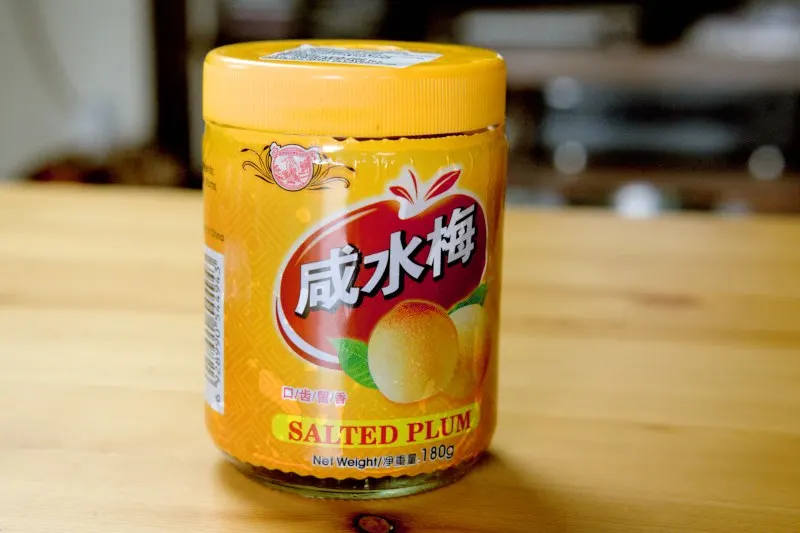
6. Other related recipes to Teochew-style steamed fish
If you enjoyed this Teochew-style steamed fish, you might be interested in exploring some other related recipes:

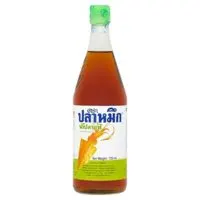


KP Kwan
Friday 22nd of November 2024
Hi, this is KP Kwan. I am happy to see you in this comment area, as you have read through my recipe. I am glad to reply to any questions and comments as soon as possible.